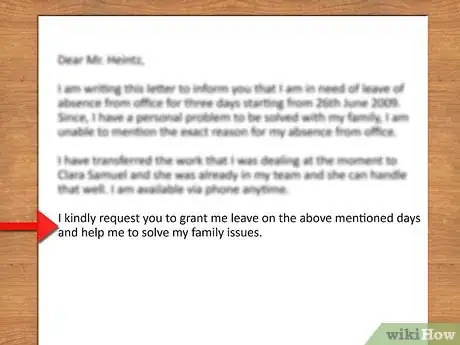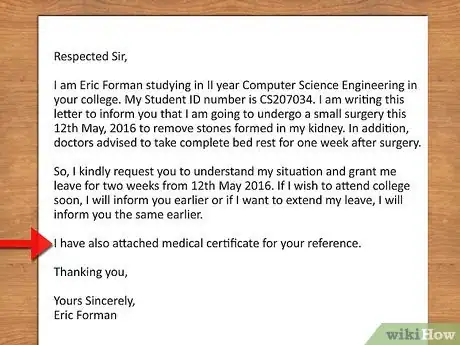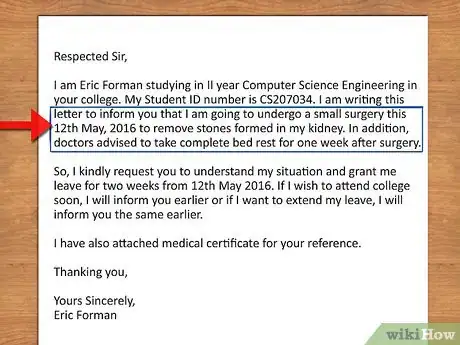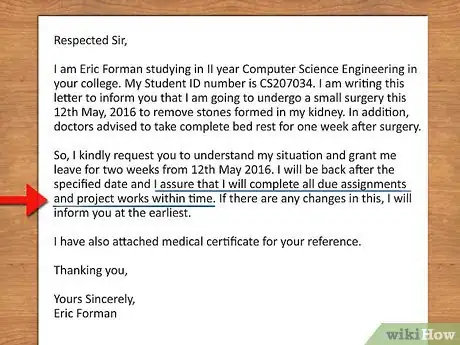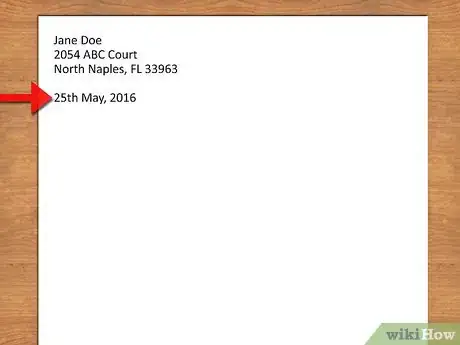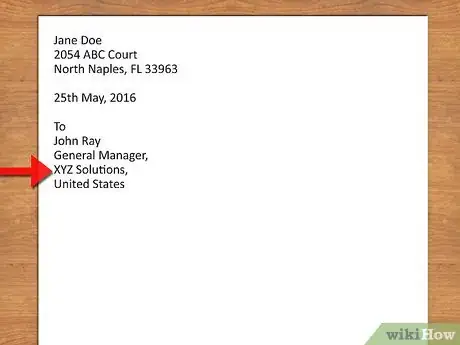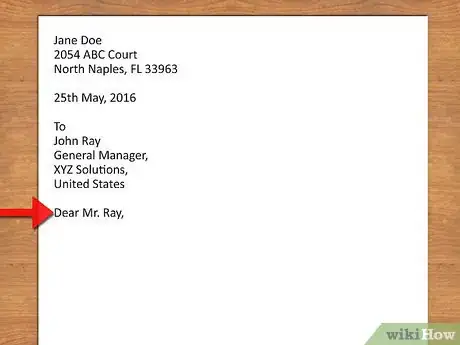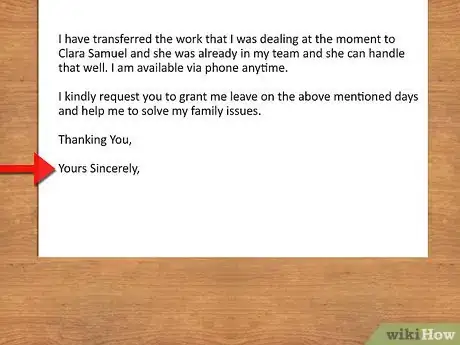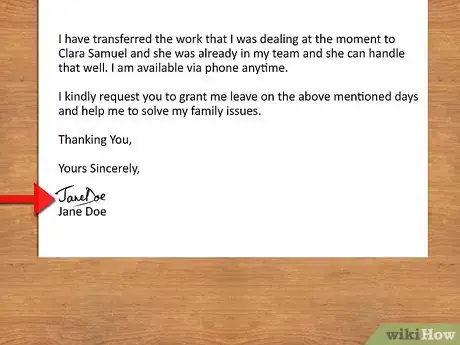This article was co-authored by Clinton M. Sandvick, JD, PhD. Clinton M. Sandvick worked as a civil litigator in California for over 7 years. He received his JD from the University of Wisconsin-Madison in 1998 and his PhD in American History from the University of Oregon in 2013.
This article has been viewed 352,728 times.
A leave of absence is time spent away from your place of work or your university. Such leave can be sought for a variety of reasons, such as illness to yourself or a family member or an extended vacation. In some cases, employees are legally entitled to certain types of absences, such as time off for the birth or adoption of a child or for providing medical care to an immediate family member. The definition of a “leave of absence” can vary depending on the length of the absence. In some cases, short-term absences, such as time away from your university or your place of work for less than a month, is not considered a leave of absence, while in other cases, even an absence as long as a week may be considered a leave of absence. It is important to determine how your employer or school defines a leave of absence before writing a leave of absence letter, as the length of your proposed absence may not be long enough to require a formal application.
Steps
Requesting a Leave of Absence from Your Employer
-
1Give an early warning to your boss. When requesting a leave of absence from your employer, it is important to give an early warning. Giving an early warning may, of course, not be possible in certain circumstances, such as the unexpected loss of a loved one. However, if giving an early warning is possible (e.g. the leave you are seeking is several weeks or months away), then try to write the letter as early as possible so that your employer and team members at work can plan accordingly.[1] A good way of giving an early warning may be to discuss the proposed leave of absence with your boss before delivering your leave of absence letter. This way your first sentence can refer to your previous discussion and the letter does not come to your boss as a surprise.
-
2Be specific about dates. State the exact dates that you plan to be away. Try not to be vague about the amount of time that you need to be away. In some cases, it may not be possible to be specific about dates, but being specific about dates will help your employer and colleagues plan ahead about how they will handle your work in your absence. Therefore, if at all possible, try to be as specific as you can in your letter about the dates that you plan to spend away from work.Advertisement
-
3Be transparent with your employer. Be as transparent as you possibly can about why you need time off. That does not mean you should reveal every minor detail about why you need to be away. In many cases, your employer may not have a right to know certain details about your personal life. However, being as transparent and honest as you can with your employer about why you need time off will minimize the possibility of conflicts with management.[2]
-
4Discuss how your work will be handled in your absence. Your letter should state that you are aware of your responsibilities and understand that before you leave, you would like to discuss how your work would be taken care of in your absence. You may include in your letter details about how you think your work will be taken care of (e.g. by leaving detailed notes for your team members on current projects that will be due during your absence, leaving contact information so that team members can reach you in an emergency).[3]
-
5Know what types of absences you are entitled to. Know that you are legally entitled to certain types of absences. It is important to differentiate between those absences that you are entitled to and those absences that may only be granted at the employer’s discretion.
- In the United States, you are entitled, for example, to up to 12 weeks of unpaid leave per year for the birth and care of a baby or for the adoption of a child under the Family and Medical Leave Act. Determine if you meet the eligibility requirements under the Act. These requirements include that you have worked for your employer for at least 12 months prior to the start of your leave and have worked at least 1250 hours in that 12 month period. Your employer must also employ at least 50 employees at your place of work or at a location within 75 miles of that location, and your employer must be a "covered employer" under the terms of the Act.[4]
- If you are writing a letter requesting an absence to which you are legally entitled, you can phrase the request accordingly. You can write, for example, “As we both know, I have the legal right to take this time off. I am hoping to take time off between (enter dates). How can we see to it that productivity continues?”[5] Moreover, asking your employer how productivity can be maintained shows a concern for your employer’s well-being and can enhance your standing at your workplace.[6]
- If you are asking for time off that is not contractually owed to you, adjust your tone to be apologetic for the inconvenience and promise to make up the lost time to the best of your abilities.
- Let your boss know if you have any accrued vacation time or sick days.
- Including this information in the letter will also make things clearer for the chain of command in the Human Resources department if your boss chooses to deny your request and you have to appeal the decision.
-
6Include ideas on how to delegate work while you are away. Although your boss will likely have final say on this, try to give helpful suggestions on which of your coworkers you think would be best suited to cover various aspects of your job in your absence. Try not to put all the burden on one person’s shoulders, however, as that would be unfair to that particular colleague.
-
7Write in a respectful tone. Whatever the circumstances, it is important that you request a leave of absence politely. You should, in other words, request rather than demand an absence, even if you are legally entitled to it. Asking nicely can minimize confrontation with management.[7]
Requesting a Leave of Absence from Your University
-
1Locate a leave of absence form. Students seeking a leave of absence from their university are generally required to fill out a form. Download a leave of absence form provided by your university department on its website. These forms should also be available at your departmental office.
-
2Fill out the form. The form will ask such information as your name, university ID number, university and permanent addresses, and degree program.
- The form will likely ask your citizenship or visa status. Leaves of absences can have visa implications for international students. This is so because if you are an international student, you have been granted a visa in order to study. If you withdraw from your studies for an extended period of time, you may be asked to return to your home country and may have to re-apply for a visa in order to return. Find out what the visa implications might be of a leave of absence if you are an international student studying on a student visa. These policies may vary by country and are set by the relevant department of state.
- At U.S. universities, the form will also ask you if you are receiving federal financial aid. If you are a student in the U.S. receiving federal financial aid, you are generally required to attend university in order to receive financial aid. A leave of absence may affect your federal aid eligibility, so it is important to contact your financial aid office and speak to a financial aid advisor for advice on how best to proceed with your leave of absence request.
-
3Write a leave of absence letter as supporting documentation. The leave of absence request should generally be accompanied by supporting documents that your university will need in order to approve your request. If you are requesting military leave, you will have to attach your military orders. If you are requesting leave for medical reasons, you will have to attach a letter written by your doctor or health-care provider. If, however, you are requesting leave for personal reasons, you will have to write a leave of absence letter explaining the circumstances and reasons for your request.
-
4Be transparent about your reasons. If your absence request is for personal reasons, it is important to be as transparent as possible with your department, so that your department can determine if your particular situation qualifies you for leave.
-
5Mention in the letter any work that you intend to do while you are away. You might, for example, be a research student requesting leave to complete your research project away from your campus at a remote location. Advanced PhD students are normally entitled to such leaves. They must, however, discuss their plans with their faculty advisors before the leave is granted, so that the advisor can certify to the department that you (the student) are likely to meet your research goals. Specify in your leave of absence letter any work that you intend to complete while away.
Formatting Your Letter
-
1Include the sender's address. It may seem unnecessary to include your own address if you work in the same building as your employer, but doing so will ensure that the letter is returned to the correct address should the Post Office fail to deliver it, and your Human Resources department will find it easier to file your letter if your address is written on it.
-
2Use the date on which the letter was completed. Often, writers date the letter when they begin it, but if you work on the letter over the course of several days, remember to change the date to the day the letter is completed and signed.
-
3Include an inside address, also known as a recipient address. Include the name of the specific addressee, including their personal title (e.g. Dr. Rogers, Prof. Smith).
-
4Use the name used in the inside address for the salutation. Even if you know your boss well, address her formally, with her professional or personal title followed by her last name.
-
5Decide which formatting style you want to use for your body paragraphs. A popular formal style is the block style, which follows the following conventions:
- Paragraphs should be single spaced.
- Lines should be left-aligned.
- Instead of indenting to begin a paragraph, all lines should begin on the left margin.
- Leave a blank line to indicate paragraph breaks.
-
6End your letter with a polite closing, such as "Yours sincerely," "Your faithful" or "Sincerely."
- Leave a blank line between the previous body paragraph and the "Sincerely."
- Leave four blank lines between the "Sincerely" and your type-written name.
-
7Sign the letter. Once you have printed the letter, sign your name in ink in the space provided by the four blank lines.
References
- ↑ http://money.usnews.com/money/careers/articles/2012/07/05/how-to-ask-for-a-leave-of-absence
- ↑ http://money.usnews.com/money/careers/articles/2012/07/05/how-to-ask-for-a-leave-of-absence
- ↑ http://money.usnews.com/money/careers/articles/2012/07/05/how-to-ask-for-a-leave-of-absence
- ↑ http://www.dol.gov/whd/regs/compliance/1421.htm
- ↑ http://money.usnews.com/money/careers/articles/2012/07/05/how-to-ask-for-a-leave-of-absence
- ↑ http://money.usnews.com/money/careers/articles/2012/07/05/how-to-ask-for-a-leave-of-absence
- ↑ http://money.usnews.com/money/careers/articles/2012/07/05/how-to-ask-for-a-leave-of-absence
About This Article
To write a leave of absence letter for your employer, start with a standard greeting and then explain in a respectful tone why you need to take the time off. Provide the specific dates you need to be away and mention how you would like your work to be handled in your absence. Try to include helpful suggestions for delegating your work while you're away, then proofread the letter carefully and submit it to your supervisor or the Human Resources department. To learn how to request a leave of absence from your university, read on!






